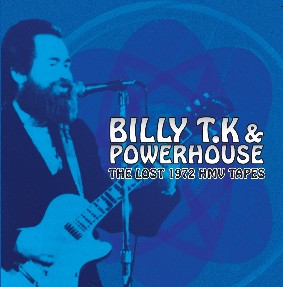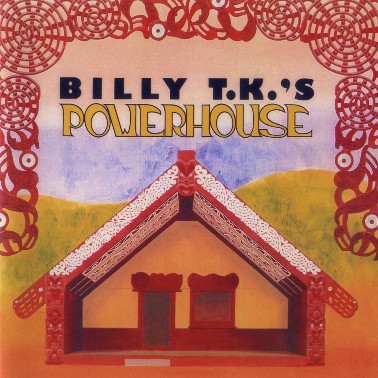|
Billy T. K & Powerhouse
Classic legacy recovered. EMI release March 2009. |
|
Liner notes for new album by Keith Newman Like so much of New Zealand’s early recorded history it was feared the debut album from Billy T.K & Powerhouse’s had been lost forever, or worse taped over, leaving little recorded evidence of this influential guitar-driven rhythmic big band.  This CD compilation of the lost Move On Up album recorded at EMI studios in 1972, with selections form the live concert at Wellington’s St James Theatre in 1975 and a single recorded with session musicians in Hollywood in 1980, delivers a solid overview of post-Instinct Billy T.K. for the first time. After three years and three albums delivering electrifying riffs as part of cult progrock trio Human Instinct, Billy T.K was ready to explore more melodic themes. Powerhouse experimented with Latin-tinged blues and funk rhythms with lush layers of vocal harmonies, brass and percussion all woven together with Billy’s relentless but unmistakeable riffs and extended solos. Billy T.K & Powerhouse began with covers and evolved to combine indigenous rhythms with experimental Santana-McLaughlin styled epics, before morphing into more of a whanau band in the 1990s as Whare Mana, often featuring dancers, actors and a full brass section. The unit was sought after to support touring international artists but never achieved mainstream recognition. From the age of 13, Billy T.K had played in bands with names like The Rubyairs and The Premiers on a circuit around the lower North Island, hammering out cover versions of Bo Diddley and Chuck Berry songs. He kept an ear on the latest music and quickly displaced traditional rock ‘n roll with bluesy covers from the likes of Spencer Davis, The Yardbirds and Pretty Things in his own band The Sinners.
Billy was among the first of a new generation of guitarists to begin
experimenting with electronic sounds. "The first guys I heard using
distortion and those kinds of effects were the Pretty Things". His friend
Ara Mete from Wellington band The Reasons, loaned him a fuzz box and treble
booster. Billy took it to an electrician and had the circuit copies and
customised. He was well into playing with controlled distortion, when he
heard Jimi Hendrix’ debut single Hey Joe and then the album Stone
Free. He felt an immediate empathy with that "electrical frequency" and
nothing was ever the same again. Billy’s fiery yet controlled style, his use of the wah wah, his Hendrix-like afro, Greer’s stand-up drumming and flowing locks, and the tumbling bass of Peter Barton (later Larry Waide and Neil Edwards), mesmerised the locals. After a short trip back to the UK the band returned with bigger, better, more capable equipment and a repertoire of originals including songs written by ex-pat Doug Jerebine for his rare Guitar Absolution album. Billy stayed with the band for three albums, Stoned Guitar, Burning Up Years and Pins In It, which elevated him and the band to legendary status. During a short tour to Australia in 1972 tensions came to the surface over musical direction and Billy stayed behind to explore his options.
Progressive rhythms The new Powerhouse featured Billy on lead, ‘The Gav’ Collinge on bass,
Ara Mete on rhythm guitar, Jamie Tait-Jamieson on keyboards and saxophone,
Arnold Tihema on congas and lead vocals, Mahia Blackmore on vocals and
percussion and Dick White on sax. Among those who turned out for drummer
auditions was Neil Storey, still in his high school uniform, who proved the
pick of the try outs. Billy T.K & Powerhouse were invited to play at the Great Ngaruawahia
Music Festival in January 1973, taking the spot just after Black Sabbath and
performing much of the repertoire they had recently recorded. There was
still no sign of the album, and according to Le Petit, when he left EMI
no-one notified the next producer about the project, so it just sat on the
shelves. In that line up Piaihana played guitar, Ara was on drums, Peter Mataparae
on bass, Temo Ponga on percussion, Maria and Eva Kuiti on background vocals
and the curious addition of cello player Pauline Pool (later Hattie of
Hattie & the Hotshots). Billy played Thin Line Fender Telecaster through a
Jansen amplifier head and a Lesley unit, designed to go with a Hammond
organ. He worked with a range of top musicians but before the planned album was completed Billy felt to return to his home land. "The musicians over there were asking me what was happening with the indigenous sounds in New Zealand. That started to play on me." In 1980 he turned up at EMI with the results of one of his US recording sessions. Dance with the Spirit an original composition backed with top session players in Hollywood was released as a single but disappeared into the ether. "I was never that good at promoting my material" On the road again At its height Billy T.K & Powerhouse, or its indigenous offspring Whare Mana, played alongside Split Enz, John Mayall, Renee Geyer, Sonny Terry and Brownie McGee, Joe Satriani and the Neville Brothers. Billy was even invited onstage in April 1996 to play alongside guitar hero Carlos Santana on Bob Marley’s Exodus. Guitar legend Billy T.K continued to work his own circuit of small town venues and festivals across both islands. Although he recorded material in many independent studios, he was never happy for anything to be released or funding ran out before completion. Billy remains best known as for his work on the first three Human Instinct albums, and features high on the list of any attempt to rate the country’s top 10 guitarists. Beyond that progrock period, few have had has the privilege of hearing
Powerhouse or Wharemana unless they were there in the audience on the night.
A suitable accolade for his contribution, might be reviewer Grant Smithies
inclusion of a comment from a reader of his Sunday Star Times column
in May 2007: "I’m surprised there’s not a statue of Billy in Queen St". While researching a programme on Blerta for Radio New Zealand National in 2006, I asked a casual question of an EMI archivist: "You don’t happen to have a Billy T.K album from around 1972 do you?" There was a long silence, some background shuffling, then "Ah, yes, here it is." I was astounded. Being able to inform Billy T.K and other members of the band that their small slice of New Zealand music history had survived 33-years intact was a great pleasure. Now that pleasure is yours. – Keith Newman, writer and radio producer. Track listing |
 Within
a couple of months he returned home with former Blackfeather drummer Steve
Webb and recruited second guitarist John Bilderbeck from Wanganui and Gav
Collinge from The Kin on bass, calling the new unit Powerhouse. Rehearsals
began in Billy’s bedroom at Bunnythorpe on the outskirts of Palmerston
North. The material included early Crosby Stills, Nash & Young, Neil Young’s
Southern Man and a 20-minute version of Elton John’s 60-Years On.
Within
a couple of months he returned home with former Blackfeather drummer Steve
Webb and recruited second guitarist John Bilderbeck from Wanganui and Gav
Collinge from The Kin on bass, calling the new unit Powerhouse. Rehearsals
began in Billy’s bedroom at Bunnythorpe on the outskirts of Palmerston
North. The material included early Crosby Stills, Nash & Young, Neil Young’s
Southern Man and a 20-minute version of Elton John’s 60-Years On.